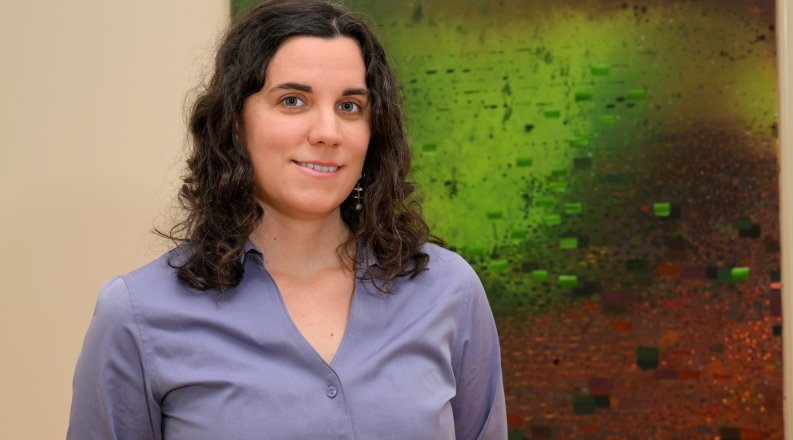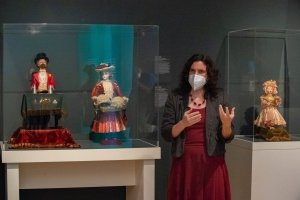By Jonah Grinkewitz
The Barry Art Museum at Old Dominion University has appointed Sara Woodbury as its first permanent curator.
Woodbury, who has served as the Barry’s guest curator since 2020, has more than a decade of experience, including stops at the Roswell Museum in New Mexico, the Shelburne Museum in Vermont and the Dallas Museum of Art, among others.
She graduated with a bachelor’s degree in art history from Lake Forest College in Lake Forest, Illinois and earned her master’s from Williams College in Williamstown, Massachusetts. She is currently completing her Ph.D. in American studies at William and Mary in Williamsburg, Virginia.
ODU News sat down with Woodbury to learn more about her background and what she will bring to this new position.
ODU News: You have a diverse background working in different museums and curatorial positions. How do you think that experience will inform your role as curator for the Barry Art Museum?
Sara Woodbury: Probably the most direct way it will inform my experience here is that the collection itself is eclectic. In terms of media, you have dolls, glass, paintings and sculptures. It’s a lot of different material spanning about two centuries. Although I haven’t worked with a lot of it directly, the experience of constantly adapting to new collections in different places has equipped me for this position. I’m very comfortable with learning new materials, subject matter and artists. The most important skill that I have isn’t so much my expertise in any one field, it’s my versatility and willingness to learn new things.
ODU News: What is your personal philosophy and approach to curating an exhibition?
SW: Two things have always interested me since I started in the field around 2010. One is the connections between different artists and artworks, whether it’s shared geography, relationships or mediums. The other is finding the lesser-known gems within a museum collection. Everybody knows the greatest hits in a particular museum, but so many collections have works that rarely get to see the light of day because they’re a fragile work on paper or they’re not by a famous artist. I would say those interests still fuel me, but what’s changed within the last three years or so is my emphasis on collaboration. The ongoing reckoning within academia has made it very clear to me that I can’t know everything. I don’t know all the stories and I don’t have all the perspectives, but that’s not a weakness — it’s an opportunity to reach out to other people who can tell those stories in better ways than I can.
ODU News: Looking at the Barry Art Museum’s collection, what really excites you and how do you view your responsibility to share those stories with the community?
SW: What excites me the most are the conversations between the different materials. The paintings and the glass actually talk to one another really well. The Barrys collected pieces with those kinds of dialogues in mind. But the dolls are among the most extensive holdings in the museum and they kind of live off in their own gallery. One thing that really interests me is getting those objects in conversation with other pieces in the collection whether it’s through highlighting the artistic processes made to create them or delving into some social history issues like economics and commerce.
In terms of ensuring representation, I’m really grateful for the committees that we assemble for each of the shows because that brings in faculty members and community members from different fields who raise questions that I might not think of. And that brings in perspectives that enrich the narratives and provide resources to me in terms of expertise or serving as sounding boards.
The most important skill that I have isn’t so much my expertise in any one field, it’s my versatility and willingness to learn new things.
ODU News: You served as guest curator at the Barry for about four years before this. What are some of your favorite shows that you’ve worked on so far?
SW: It’s such a hard question because my favorite show tends to be what I’m working on at that moment. This isn’t unique to me, but as soon as an exhibition goes up, you’re already thinking about the next project. Each one has had different facets that I’ve enjoyed about it. “Motion/Emotion” was fun because I had the opportunity to talk more in depth with the STEM faculty that I may not have worked with otherwise. “Rhonda Holy Bear” was a powerful experience. She is a Lakota doll maker and does exquisite work. For me, the most important part was making sure that her voice was the primary curatorial one, so I saw myself very much as a facilitator rather than the curator.
I’ve enjoyed the doll shows because I didn’t grow up a doll person – I was more of a stuffed animal kid – but working on those shows has gotten me to think about them through larger social history lenses like business and commerce, especially with the women entrepreneurs. It encourages me to think about how students can use this collection and what will bring them in. Maybe they’re not as interested in the details of the doll construction, but they’re working on a paper in gender studies or writing an economics paper in art history and those objects can speak to that.
ODU News: That’s a great lead-in to my next question, which is how do you plan to engage students and the community through the museum’s collection?
SW: One thing that I would love to do as I get settled into the role is work more directly with faculty and learn what they’re teaching in their classes so we can serve them and their students. What kind of assignments or research projects are they doing and how can our collection support those? Another way is to work with our fantastic gallery guides from a curatorial angle. When I was starting out doing internships, having the opportunity to work on my own shows was a phenomenal experience and it really helped with my career, so I’d love to pay that forward. In terms of the community, certainly the advisory committees are important, but also getting involved with the community itself, going to different organizations and vendors to see what they’re interested in.
ODU News: You’ll be the first permanent curator for the Barry Art Museum. How does that change things for you and what opportunities do you see for leading curation?
SW: The Barry is a young institution. Most of the museums I’ve worked at were at least 70 years old. That means that they have an institutional history with their own traditions, baggage – whatever you want to call it – and whether you’re subverting it or embracing it, you still have to acknowledge that legacy. Knowing that the Barry has only been open for five years and it’s on the cusp of an expansion, the museum is in a state of growth that I haven’t encountered before. But it’s also an exciting time because the museum field itself is always changing. I know a common critique is that museums are stuffy institutions that are hesitant to change – and yes, I agree to an extent – but they can and do change over time. That means that curatorial roles have evolved and it’s exciting to step into this at a time when you can rethink what a curator does. Especially since I’ve spent the past three years writing a dissertation that looks at the history of museum operations; I’ve had plenty of time to think about it in the abstract. This institution is a great place to start that process.
ODU News: What excites you about art?
SW: On a selfish level, art excites me because I make it myself. Before I got into art history, I grew up drawing and painting. Beyond that, art interests me for its connections to society at large. As an art historian, I love seeing the connections that develop between different geographic regions, different individuals, broader social anxieties and how art expresses – or doesn’t express – those anxieties. Art is vital to our mental health, our sense of self and finding our way in the world whether you’re trying to make a big political statement or you’re just sketching what you see on your tabletop.
ODU News: Any final thoughts on your new role and the future of the Barry Art Museum?
SW: I’m excited to be here and I want to see this museum be a resource for students, so I am at their service. Whether they’re working on a project, they need a study space or they want to get into the museum field and use the Barry as a place to reimagine what curation work is like, we’re here for them.




